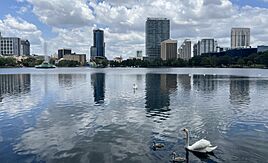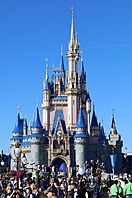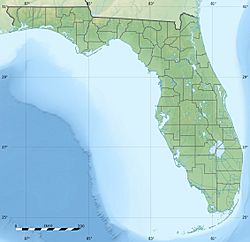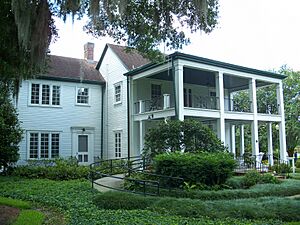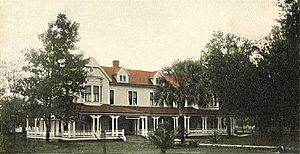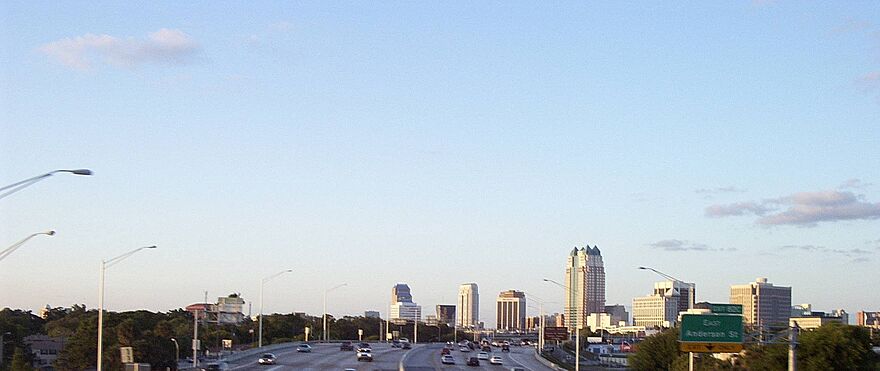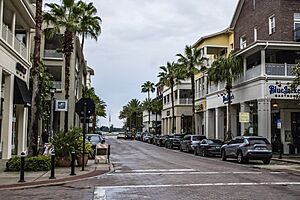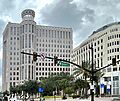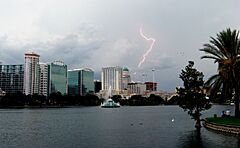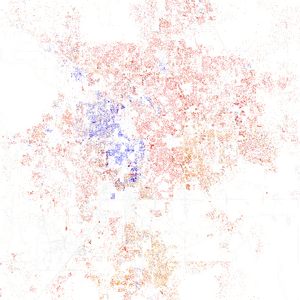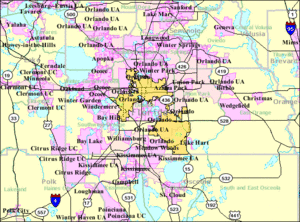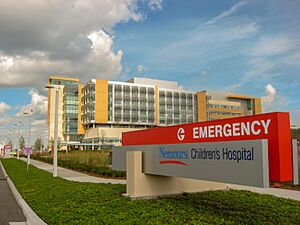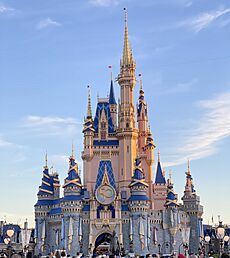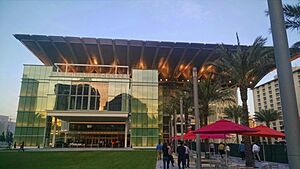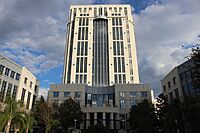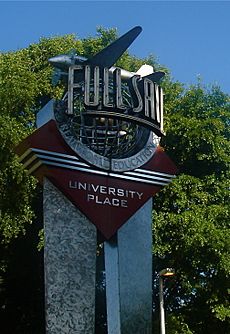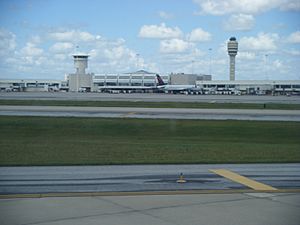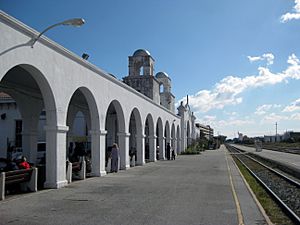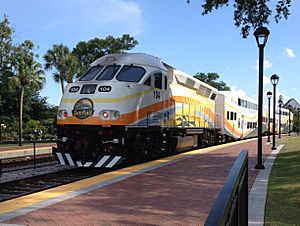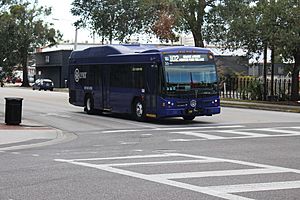Orlando, Florida facts for kids
Orlando is a large city in Florida, United States. It is known as the "Theme Park Capital of the World" because it has many famous attractions. These include Walt Disney World and Universal Orlando, which bring millions of visitors each year. Orlando is also a major center for conferences and events.
The city is home to the University of Central Florida, one of the biggest universities in the U.S. Orlando also has professional sports teams like the Orlando Magic (basketball) and Orlando City SC (soccer).
Quick facts for kids
Orlando
|
|||
|---|---|---|---|
|
|
|||
|
|||
| Nicknames:
The City Beautiful, O-Town, Theme Park Capital of the World
|
|||
| Country | |||
| State | |||
| County | Orange | ||
| Settled (Jernigan) | 1843 | ||
| Incorporated (Town of Orlando) | July 31, 1875 | ||
| Incorporated (City of Orlando) | February 4, 1885 | ||
| Named for | Orlando Reeves, a soldier killed during the Seminole War | ||
| Government | |||
| • Type | Strong Mayor–Council | ||
| Area | |||
| • Total | 119.08 sq mi (308.41 km2) | ||
| • Land | 110.85 sq mi (287.10 km2) | ||
| • Water | 8.23 sq mi (21.31 km2) | ||
| • Urban | 644.61 sq mi (1,669.5 km2) | ||
| Elevation | 89 ft (27 m) | ||
| Population
(2020)
|
|||
| • Total | 307,573 | ||
| • Estimate
(2024)
|
334,854 |
||
| • Rank | 58th in U.S. | ||
| • Density | 2,774.65/sq mi (1,071.30/km2) | ||
| • Urban | 1,853,896 (26th U.S.) | ||
| • Urban density | 2,876.0/sq mi (1,110.4/km2) | ||
| • Metro | 2,691,925 (20th U.S.) | ||
| • CSA | 4,222,422 (15th U.S.) | ||
| Demonym(s) | Orlandoan | ||
| GDP | |||
| • Metro | $217.038 billion (2023) | ||
| Time zone | UTC−5 (EST) | ||
| • Summer (DST) | UTC−4 (EDT) | ||
| ZIP Code |
32801-32812, 32814-32822, 32824-32837, 32839, 32853-32862, 32867-32869, 32872, 32877-32878, 32885-32887, 32891, 32896-32897, 32899
|
||
| Area codes | 407, 689 | ||
| FIPS code | 12-53000 | ||
| GNIS feature ID | 2404443 | ||
| Website | www.orlando.gov | ||
Orlando (![]() i/ɔːrˈlændoʊ/ or-LAN-doh) is a city in Orange County, Florida. It is the fourth-most populated city in Florida and the biggest inland city. In 2020, its population was 307,573. The larger Orlando area, including nearby towns, has over 2.94 million people.
i/ɔːrˈlændoʊ/ or-LAN-doh) is a city in Orange County, Florida. It is the fourth-most populated city in Florida and the biggest inland city. In 2020, its population was 307,573. The larger Orlando area, including nearby towns, has over 2.94 million people.
Orlando is one of the most visited cities in the world. This is mainly because of its many tourist attractions, big events, and conventions. It is the fourth-most visited city in the U.S. Orlando International Airport is one of the busiest airports in the United States. The two most famous attractions are Walt Disney World and Universal Orlando. Walt Disney World opened in 1971 and is just outside Orlando. Universal Orlando opened in 1990 and is inside the city.
Besides theme parks, downtown Orlando has major cultural places like the Orlando Museum of Art and the Dr. Phillips Center for the Performing Arts. Other attractions, like the Orlando Eye at ICON Park, are on International Drive. Orlando is also a very popular city for conferences. The Orange County Convention Center is the second-largest convention center in the U.S.
Contents
The Name of Orlando
The area where Orlando is now was once called Fort Gatlin. This fort was built in 1838 during a war. It was named after John S. Gatlin, an Army doctor. Later, settlers built a community there.
Before it was called Orlando, the area was known as Jernigan. This name came from the first European settlers, Isaac and Aaron Jernigan, who moved there in 1843. A post office opened in Jernigan in 1850. By 1856, it became the main town of Orange County.
In 1857, people debated what to name the town. One story says that a local resident, James Speer, suggested the name Orlando. He said people often called the place "Orlando's Grave." He suggested dropping "grave" and just calling it Orlando.
Stories Behind the Name
There are a few stories about how Orlando got its name. The most common one is about a man who died in 1835 during a conflict with Native Americans. Some stories say a marker was found for a person named Orlando. One version says a man named Orlando was traveling to Tampa with oxen, died, and was buried there.
Another popular story is that the city was named after a character from William Shakespeare's play As You Like It. James Speer, who helped change the town's name, was a big fan of Shakespeare. He might have used the story of the soldier Orlando to help his idea of naming the town after the play's character. This is now the most widely accepted story.
The Orlando Reeves Legend
Historians believe there was likely no soldier named Orlando Reeves. The legend says Reeves was a guard for soldiers camping near Lake Eola. He was supposedly killed during an attack. This story became popular in the early 1900s. A memorial near Lake Eola marks the spot where this soldier supposedly fell.
However, military records from the 1970s and 1980s found no soldier named Orlando Reeves. Some versions of the story try to link it to other people named Orlando in old records.
Shakespearean Inspiration
Another story, shared by Judge Donald A. Cheney in 1975, says James Speer proposed the name Orlando after the main character in Shakespeare's play As You Like It. Speer was a cultured man who admired Shakespeare. He thought the area was like the "Forest of Arden" from the play. Speer's family has confirmed this story.
Interestingly, one of downtown Orlando's main streets is named Rosalind Avenue. Rosalind is the heroine of As You Like It, which could be a fun coincidence.
History of Orlando
Early Settlement and Growth
In 1823, a Native American reservation was created in central Florida, including the Orlando area. White settlers were encouraged to move there in 1842. The first settler, Aaron Jernigan, arrived in 1843.
In 1845, Mosquito County was renamed Orange County. The main town, Orlando, was planned in 1857. It had four streets around a courthouse square. The town grew after the American Civil War. Orlando became an official town on July 31, 1875, with 85 residents. It became a city in 1885.
From 1875 to 1895, Orlando was known as the center of Florida's citrus industry. This time was called Orlando's Golden Era. However, a very cold winter in 1894–95, known as the Great Freeze, damaged many citrus groves. This caused many people to move away.
Modern Development
Orlando became a popular vacation spot before World War I. In the 1920s, many new homes were built during a land boom. This boom ended with hurricanes and the Great Depression.
During World War II, many Army personnel were stationed at bases in Orlando. Some of these service members stayed and made Orlando their home. In 1956, the company Lockheed Martin opened a plant in the city. Military bases like Orlando Air Force Base and McCoy Air Force Base were important to the city's growth. McCoy Air Force Base later became part of the Orlando International Airport.
A big change for Orlando happened in 1962 when the new Orlando Jetport was built. This airport, now Orlando International Airport, helped bring more visitors. In 1965, Walt Disney announced plans to build Walt Disney World near Orlando. He chose Orlando because its inland location offered more protection from hurricanes than coastal areas. Walt Disney World opened in October 1971. This led to huge growth in population and the economy for the Orlando area. Tourism became the most important part of the area's economy.
Downtown Orlando Today

Today, the historic part of Orlando is in downtown Orlando around Church Street. The downtown area has grown quickly with many new buildings. The historic neighborhoods around Lake Eola have some of the oldest homes in Orlando.
A Community Comes Together
In June 2016, a tragic event occurred at a nightclub in Orlando. The community came together to support those affected and remember the lives lost. The city's mayor announced plans to create a permanent memorial at the site to honor the victims. This showed the strength and unity of the Orlando community.
Orlando's Geography
Orlando's landscape has many lakes and wet areas, called wetlands. The land is mostly flat and low. There are hundreds of lakes, with Lake Apopka being the largest. The ground in Orlando is made of limestone, which is porous. This means the area can have sinkholes. A famous sinkhole happened in 1981 in Winter Park, just north of downtown Orlando.
City Layout and Neighborhoods
Orlando's Neighborhoods
Orlando has 115 neighborhoods within its city limits. There are also many communities nearby that are not officially part of the city. This makes Orlando's city map look like a checkerboard. The city and county are working to make the city limits more organized.
Downtown Orlando is the historic center of the city. It has many banks, tall buildings, government offices, and cultural attractions. It is also home to many people.
Southeast of downtown is Lake Nona, a fast-growing area. It is known as the city's health district, with places like the University of Central Florida's Health Sciences Campus and Nemours Children's Hospital.
In southwest Orlando, you'll find the main tourist area. International Drive, or I-Drive, is a long road with many attractions. These include Universal Orlando, Madame Tussauds wax museum, the Orange County Convention Center, SeaWorld Orlando, and ICON Park with its famous ferris wheel, the Orlando Eye.
The western side of Orlando has neighborhoods like Apopka and Windermere. The north side includes older neighborhoods like Eatonville and Winter Park. The east side is home to the University of Central Florida (UCF), which has a very large student body.
A list of major neighborhoods and suburbs:

- Downtown Orlando
- Winter Park
- Celebration
- Pine Hills
- Windermere
- Dr. Phillips
- Hunter's Creek
- Lake Nona
- Baldwin Park
- Parramore
- Williamsburg
- Lake Buena Vista
- Bay Lake
- Kissimmee
- Winter Garden
- Eatonville
- Poinciana
- Maitland
- Apopka
- Casselberry
- Four Corners
- Altamonte Springs
- Meadow Woods
- Edgewood
- MetroWest
- College Park
- Wedgefield
- Avalon Park
Tall Buildings in Orlando
The Orlando area has 19 completed skyscrapers. Most are in downtown Orlando. Buildings in downtown Orlando have not been built taller than 441 feet since 1988. This is because of the Orlando Executive Airport nearby, which has height limits for buildings.
Downtown Orlando Skyscrapers
- 200 South Orange, 1988, 441 feet, the tallest skyscraper in the Orlando area.
- The Vue at Lake Eola, 2008, 426 feet.
- Orange County Courthouse, 1997, 416 feet.
- Bank of America Center, 1988, 409 feet.
- 55 West on the Esplanade, 2009, 377 feet.
- Solaire at the Plaza, 2006, 359 feet.
- Church Street Plaza Tower 1, 2019, 315 feet.
- Dynetech Center, 2009, 357 feet.
- Regions Bank Tower, 1986, 292 feet.
- Premiere Trade Plaza Office Tower II 2006, 277 feet.
- Citrus Center, 1971, 281 feet.
- Citi Tower, 2017, 275 feet.
- SkyHouse Orlando, 2013, 262 feet.
- Modera Central, 2018, 260 feet.
- The Waverly on Lake Eola, 2001, 280 feet.
Skyscrapers Outside Downtown Orlando
- Hyatt Regency Orlando, 2010, 428 feet.
- SeaWorld SkyTower, 400 feet.
- The Wheel at ICON Park, 2015, 400 feet.
- Orlando International Airport's ATC tower, 2002, 346 feet.
- StarFlyer Orlando on International Drive, 2018, 450 feet.
Orlando's Climate
Orlando has a warm and humid climate. It has two main seasons. From May to late October, it is very hot and rainy. This time also lines up with hurricane season. From November to April, it is mild and dry.
In summer, high temperatures are usually around 90°F (32–34°C). Low temperatures rarely drop below 70°F (22–24°C). The humidity makes it feel even hotter. Strong thunderstorms happen almost every day in the afternoon. These storms bring lots of lightning, heavy rain, and strong winds.
In winter, it is less humid and temperatures are milder. Temperatures rarely go below freezing. Snow is very rare in Orlando. The last time snow accumulated in the city was in 1948.
Orlando gets about 51 inches of rain each year. Most of this rain falls from June to September. The dry season, from October to May, can sometimes have wildfire risks.
Orlando is inland, so hurricanes usually weaken before they arrive. However, strong hurricanes can still cause damage. In 2004, three hurricanes hit Orlando, with Hurricane Charley causing the most damage. More recently, hurricanes Irma (2017), Ian (2022), and Milton (2024) also caused notable damage.
Tornadoes are not common during summer thunderstorms. They are more likely in winter or during hurricanes.
Orlando's People
| Historical population | ||
|---|---|---|
| Year | Pop. | ±% |
| 1890 | 2,856 | — |
| 1900 | 2,481 | −13.1% |
| 1910 | 3,894 | +57.0% |
| 1920 | 9,282 | +138.4% |
| 1930 | 27,330 | +194.4% |
| 1940 | 36,736 | +34.4% |
| 1950 | 52,367 | +42.5% |
| 1960 | 88,135 | +68.3% |
| 1970 | 99,006 | +12.3% |
| 1980 | 128,251 | +29.5% |
| 1990 | 164,693 | +28.4% |
| 2000 | 185,951 | +12.9% |
| 2010 | 238,300 | +28.2% |
| 2020 | 307,573 | +29.1% |
| 2024 | 334,854 | +8.9% |
| Population 1890–2010 Source: U.S. Decennial Census |
||
In 2020, Orlando had 307,573 people living in the city.
Orlando has a very diverse population. It has the largest number of Puerto Ricans in Florida, and their community is growing fast. Many people from Cuba, the Dominican Republic, and Colombia also live here. Orlando also has a large and growing Brazilian population. You can find Brazilian restaurants and shops, and Portuguese signs at the airport.
There are also many people from the Caribbean, especially Haitians and Jamaicans. Orlando has a large Muslim population and an active Jewish community.
Orlando is known for being a welcoming city for the LGBTQ+ community. About 4.1% of Orlando's population identifies as LGBTQ+. The city hosts "Gay Days" at Walt Disney World every June and a big Pride festival and parade every October.
Languages Spoken in Orlando
Most residents in Orlando speak English at home. However, many other languages are spoken too. In 2000, 16.60% of people spoke Spanish, 1.9% spoke Haitian Creole, and 1.3% spoke French. Overall, 24% of people aged 5 and older speak a language other than English at home.
Greater Orlando Area
Orlando is the main city of the Orlando–Kissimmee–Sanford, Florida Metropolitan Statistical Area, also called "Greater Orlando" or "Metro Orlando". This area includes four counties: Lake, Orange, Osceola, and Seminole. In 2020, the population of this area was 2,673,376, making it the third largest in Florida.
Orlando's Economy
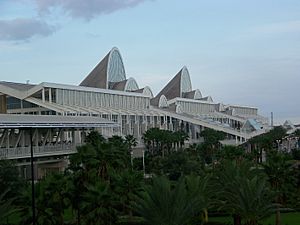
Orlando is a big center for industry and technology. The metro area has a $13.4 billion technology industry with 53,000 workers. It is known for new ideas in digital media, farming technology, aviation, aerospace, and software design. Over 150 international companies from about 20 countries have offices in Metro Orlando.
Orlando has the 7th-largest research park in the country, Central Florida Research Park. It has over 120 companies and more than 8,500 employees. It is a major hub for military simulation and training programs.
Lockheed Martin has a large factory in Orlando that makes missile systems and other high-tech products. Many other engineering companies also have offices or labs here.
Orlando is close to Patrick Space Force Base, Cape Canaveral Space Force Station, and Kennedy Space Center. This allows people to work in the space industry and live in Orlando's suburbs. It also provides easy access to Port Canaveral, a port for cruise ships.
Orlando is the home of Darden Restaurants, which owns popular restaurants like Olive Garden and LongHorn Steakhouse.
Film, TV, and Entertainment
Orlando is also important for the film, television, and video game industries. This is thanks to places like Universal Studios Florida, Disney's Hollywood Studios, Full Sail University, and the University of Central Florida College of Arts and Humanities. The U.S. military's modeling, simulation, and training industry is also centered in Orlando.
Electronic Arts, a video game company, has a division called Tiburon in nearby Maitland. Full Sail University in Winter Park trains students in video game design, film, and computer animation. Many graduates start new companies in Orlando. The headquarters of Ripley Entertainment Inc. are also in Orlando.
The Florida Film Festival takes place in Orlando and attracts filmmakers from around the world. Orlando's independent film scene has been active, with films like The Blair Witch Project and Monster having connections to the area.
Healthcare in Orlando
Orlando has two major hospital systems: Orlando Health and AdventHealth. Orlando Regional Medical Center has Central Florida's only Level I trauma center. Winnie Palmer Hospital for Women and Babies and AdventHealth Orlando have special care units for newborns. Orlando's medical field has grown with the University of Central Florida's College of Medicine, a new VA Hospital, and the new Nemours Children's Hospital in the Lake Nona Medical City area.
Tourism and Attractions
Tourism is a huge part of Orlando's economy. The city is one of the top tourist spots in the world. It's called the 'Theme Park Capital of the World'. The Orlando area has Walt Disney World, Universal Orlando, SeaWorld Orlando, Legoland Florida, and Fun Spot America Theme Parks. In 2018, a record 75 million visitors came to the Orlando region.
The Orlando area has 7 of the 10 most visited theme parks in North America. Walt Disney World is the biggest attraction, with parks like Magic Kingdom, Epcot, Disney's Hollywood Studios, and Disney's Animal Kingdom. Universal Orlando has Universal Studios Florida, Universal Islands of Adventure, and Universal Volcano Bay. SeaWorld Orlando has marine animals and roller coasters. Other attractions include Fun Spot Orlando and ICON Park with The Wheel.
The convention industry is also very important. The Orange County Convention Center is the second-largest convention center in the United States. Orlando competes with Chicago and Las Vegas for hosting the most convention attendees.
Golf in Orlando
Orlando has many golf courses. The most famous is Bay Hill Club and Lodge, which hosts the Arnold Palmer Invitational golf tournament.
Culture and Arts
Film and TV Production
In the 1990s, Orlando was known as "Hollywood East" because many films and TV shows were made here. For example, a scene from the movie Lethal Weapon 3 involved the old Orlando City Hall. The film Passenger 57, starring Orlando native Wesley Snipes, was also filmed mostly in his hometown.
Universal Studios Florida and Disney's Hollywood Studios were once busy with productions. While film activity has slowed, Orlando still hosts the Florida Film Festival. Independent films like The Blair Witch Project and Monster have connections to Orlando.
Theater and Performing Arts
Orlando has a lively theater scene. There are professional and community theaters, including the Central Florida Ballet and Orlando Shakespeare Theater. The Dr. Phillips Center for the Performing Arts hosts many shows.
The Orlando International Fringe Theater Festival brings theater groups from around the world to Orlando every spring. The Orlando Cabaret Festival also showcases talented artists. Orlando has two professional orchestras, the Orlando Symphony Orchestra and the Orlando Philharmonic Orchestra.
Literary Arts
Orlando has independent literary publishers like Burrow Press. The city is also known for its slam poets and poetry events, earning it the nickname "Litlando." It's said that the city's name and Rosalind Avenue were inspired by characters from Shakespeare's play As You Like It.
Music and Local Scene
Orlando has many recording studios and has been important in the music industry. Famous groups like the Backstreet Boys and *NSYNC were formed here. Rock bands like Matchbox Twenty and Alter Bridge are also from Orlando. The city has a strong metal music scene with bands like Death and Trivium.
Orlando also has active hip hop, rock, and Latino music scenes. The Vans Warped Tour, a concert featuring metalcore, screamo, and punk bands, used to visit Orlando every year.
Shopping Malls
- The Mall at Millenia is a large, upscale shopping mall with department stores like Bloomingdale's and Macy's. An IKEA store opened next to the mall in 2007.
- Orlando Fashion Square is located near Downtown Orlando.
- Orlando International Premium Outlets is an outdoor outlet mall with over 180 stores.
Entertainment Districts
- Universal CityWalk is an entertainment and shopping area at the entrance of Universal Studios Florida. It opened in 1999 as part of the expansion that made Universal Studios Florida into the big resort it is today.
Sports in Orlando


Orlando is home to two major professional sports teams: the Orlando Magic (basketball) and Orlando City SC (soccer).
The city also has minor league professional teams: the Orlando Solar Bears (ice hockey), the Orlando Predators (arena football), the Orlando Anarchy (women's football), and the Orlando Valkyries (women's volleyball).
The Orlando Pride women's soccer team started playing in 2016. They share Inter&Co Stadium with Orlando City SC.
Orlando has hosted the NBA All-Star Game twice, in 1992 and 2012.
The city is also home to the University of Central Florida (UCF) Knights college sports teams. They compete in NCAA Division I.
Camping World Stadium hosts two annual college football bowl games: the Citrus Bowl and the Pop-Tarts Bowl. It also hosts the annual Florida Classic football game. In 2016, it began hosting the National Football League's Pro Bowl.
In 2020, the remaining games of the 2019–20 NBA season were played in a special "NBA Bubble" at the ESPN Wide World of Sports Complex near Orlando.
Many famous athletes have lived in Orlando, including basketball players Shaquille O'Neal and Tracy McGrady, soccer players Alex Morgan and Kaká, and golfers Tiger Woods and Arnold Palmer.
The annual Community Effort Orlando (CEO) is the second-biggest fighting game tournament in the country.
The following are the major professional sports teams in the Orlando area:
| Club | Sport | League | Venue | Average attendance | Founded | Titles |
|---|---|---|---|---|---|---|
| Orlando Magic | Basketball | NBA | Kia Center | 16,785 | 1989 | 0 |
| Orlando City SC | Soccer | MLS | Inter&Co Stadium | 20,404 | 2015 | 0 |
| Orlando Predators | Arena football | N/A | Kia Center | — | 1991 & 2019 | 0 |
| Orlando Solar Bears | Ice hockey | ECHL | Kia Center | 6,209 | 2012 | 0 |
| Orlando Anarchy | Women's football | WFA | Trinity Preparatory School | — | 2010 | 1 |
| Orlando Pride | Women's soccer | NWSL | Inter&Co Stadium | 4,837 | 2016 | 1 |
| Orlando Valkyries | Women’s Indoor Volleyball | PVF | Addition Financial Arena | - | 2023 | 1 |
Government and Education
City Government
Orlando is governed by a mayor and a city council. The mayor is elected by the whole city. The six members of the city council are each elected from different districts. Mayor: Buddy Dyer
| District | Name |
|---|---|
| 1 | Jim Gray |
| 2 | Tony Ortiz |
| 3 | Robert Stuart |
| 4 | Patty Sheehan |
| 5 | Shan Rose (interim) |
| 6 | Bakari F. Burns |
Orlando has become a strong Democratic city in recent years.
Schools and Colleges
Public schools in Orlando are managed by Orange County Public Schools. There are also many private schools, like St. James Cathedral School and Lake Highland Preparatory School.
Higher Education
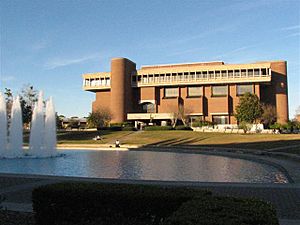
Orlando has several universities and colleges:
- University of Central Florida
- Florida A&M University College of Law
- Florida State University College of Medicine
- Valencia College
- Seminole State College of Florida
- Full Sail University (in Winter Park)
- Rollins College (in Winter Park)
Public Libraries
The main public library system in Orlando is the Orange County Library System (OCLS). It has 15 branches across Orange County. The OCLS offers many resources like books, computers, 3D printers, and classes for all ages.
The first public library in Orlando, the Albertson Public Library, opened in 1923. A year later, the Booker T. Washington branch, Orlando's first African-American library, opened.
Media in Orlando
Television
Orlando is a major media market in the United States. It has several major TV stations:
- WKMG-TV 6 (CBS)
- WFTV 9 (ABC)
- WOFL 35 (Fox)
- WESH 2 (NBC)
There are also public television stations and Spanish-language channels.
Radio
Orlando has many AM and FM radio stations. Big radio companies like iHeartMedia and Cox Radio have a strong presence here.
Newspapers
Orlando's main newspaper is the Orlando Sentinel. It is the second-largest newspaper in Florida. It also has a Spanish-language edition called El Sentinel.
Other newspapers include:
- Orlando Business Journal
- Orlando Weekly
Transportation in Orlando
Orlando uses the Lynx bus system for local travel. Downtown Orlando also has a bus service called Lymmo. SunRail, a commuter train, started service in 2014, connecting Orlando with nearby communities.
Airports
- Orlando International Airport (MCO) is Orlando's main airport and the busiest in Florida. It is a major hub for airlines like Frontier Airlines, JetBlue Airways, and Southwest Airlines. It also serves as a big gateway for international flights.
- Orlando Sanford International Airport (SFB) is a smaller airport in nearby Sanford.
- Orlando Executive Airport (ORL) near Downtown Orlando is mainly used for private jets and flight training.
Roads and Highways
Orlando often has traffic jams, especially during morning and afternoon rush hours. There are many resources to help commuters with traffic information.
Major Roads
 I-4 is Orlando's main interstate highway. It runs from Tampa through Orlando to Daytona Beach. It connects Orlando's suburbs, downtown, and attractions.
I-4 is Orlando's main interstate highway. It runs from Tampa through Orlando to Daytona Beach. It connects Orlando's suburbs, downtown, and attractions. East-West Expressway (Toll 408) is a major east–west highway that goes through downtown Orlando.
East-West Expressway (Toll 408) is a major east–west highway that goes through downtown Orlando. Beachline Expressway (Toll 528) provides access to the Orlando International Airport and the Atlantic coast.
Beachline Expressway (Toll 528) provides access to the Orlando International Airport and the Atlantic coast. Central Florida Greeneway (Toll 417) is a highway that circles eastern Orlando.
Central Florida Greeneway (Toll 417) is a highway that circles eastern Orlando. Daniel Webster Western Beltway (Toll 429) circles western Orlando and provides a "back entrance" to Walt Disney World.
Daniel Webster Western Beltway (Toll 429) circles western Orlando and provides a "back entrance" to Walt Disney World. Florida's Turnpike is a major highway connecting northern Florida with Orlando and Miami.
Florida's Turnpike is a major highway connecting northern Florida with Orlando and Miami.
Train Services
Orlando has train service from Amtrak. The Orlando Amtrak Station has been in use since 1927. Amtrak's Silver Meteor and Floridian trains serve Orlando daily, connecting to cities like New York City, Chicago, and Miami.
Commuter Rail
SunRail is a local commuter train service that started in 2014. It runs between DeBary and Poinciana, passing through downtown Orlando. This service helps reduce traffic on I-4.
Inter-city Rail

Brightline is a private train service that connects Miami to Orlando. It started service to Orlando in September 2023. The trains can reach speeds of 125 mph. There are plans to add a station near Disney Springs in the future.
Bus and Taxi Services
Lynx provides local bus service across a five-county area around Orlando. Greyhound Lines offers bus service to other cities across the country.
Orlando also has many taxi companies and ride-sharing services like Uber and Lyft. Airport shuttle services provide transportation between Orlando International Airport and various locations.
International Connections
Sister Cities
Orlando has sister city relationships with several cities around the world:
- Curitiba, Brazil
- Guilin, China
- Monterrey, Mexico
- Reykjanesbaer, Iceland
- Seine-et-Marne, France
- Tainan, Taiwan
- Urayasu, Japan
- Valladolid, Spain
Foreign Consulates
Because Orlando is a popular international tourist spot and has a growing business base, many countries have consulates or honorary consulates here. As of April 2023, these include Austria, Brazil, Chile, Colombia, France, Germany, Haiti, Japan, Mexico, and the Netherlands.
See also
 In Spanish: Orlando (Florida) para niños
In Spanish: Orlando (Florida) para niños


